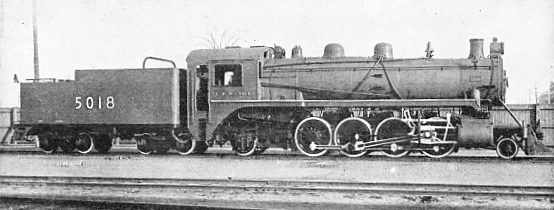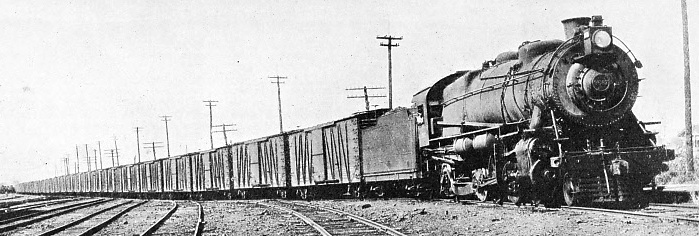
© Railway Wonders of the World 2012-


The “Mikado” Type of Locomotive
The 2-

CANADIAN PACIFIC RAILWAY “MIKADO”. Its cylinders are 23½ by 32½ inches; working pressure, 180 lb to the square inch; and driving wheels, 63 inches in diameter. Total heating surface, 4,358 square feet. Ready for the road, the complete locomotive weighs 428,000 lb, and develops a tractive effort of 42,000 lb.
JAPAN was responsible for fostering the creation of one distinctive member of the family of locomotives. Increasing goods traffic in the island kingdom called for more power, and the “Consolidation”, despite its perfection, could not satisfactorily meet the situation. The fuel forthcoming was a most inferior quality of coal, with the result that the effective combustion necessitated a large grate area combined with a fire-
The construction of the new series of locomotives was entrusted to the Baldwin Locomotive Works, whose technicians, in the resolve to satisfy the Japanese requirements, took the established “Consolidation” and gave it a wide, deep fire-
arrangement 2-
Although the “Mikado” has many decided advantages over the “Consolidation”, notably increased steaming capacity in proportion to adhesion, it did not attract the serious attention of the world’s railways until 1902. In that year an American company requested the Baldwin Locomotive Works to provide them with an engine capable of using lignite as fuel. As the duty was broadly identical with that for which the Japanese locomotives had been designed, the builders suggested the “Mikado”, because this design would assure the requisite fire-
This 2-

POWERFUL “MIKADO” LOCOMOTIVE BUILT FOR THE DELAWARE, LACKWANNA, AND WESTERN RAILROAD, 1922. Ready for the road, this giant weighs 628,100 lb. With “booster”, it has a maximum tractive effort of 79,200 lb.
The wonderful development of the “Mikado” type is reflected by the 2-
The tender is of the eight-

“MIKADO” LOCOMOTIVE BUILT FOR THE LEHIGH VALLEY RAILROAD, 1923. The type owes its name to the fact of having been introduced upon the Imperial railways of Japan. This locomotive is fitted with Duplex automatic stoker and “booster”, and weighs, complete, 481,540 lb.
The Lehigh Valley Railroad “Mikado” went into service in the spring of 1923 to a handle the heaviest coal trains which had exceeded the hauling capacity of the largest “Consolidation” then in operation, at relatively high speeds, especially over the freight line threading Wilkesbarre Mountain with its grade of 61 feet per mile. It has cylinders 27 by 30 inches, using steam at a pressure of 200 lb, and drivers 63 inches in diameter. It is equipped with the Duplex automatic stoker and “booster”. Its total weight is 481,540 lb -
The “Mikado” is also favoured by the Pennsylvania system for general freight haulage; its engines are among the largest engaged primarily in heavy duty. They have driving wheels 62 inches in diameter, and trailing wheels of 50 inches. The total wheel-

STRIKING PERFORMANCE OF THE PENNSYLVANIA RAILROAD “MIKADO”. A solid train of 50 cars of wheat was hauled from Buffalo to Philadelphia, via Williamsport and Harrisburg -
These locomotives have been responsible for some striking running performances. One was the movement of a train load of 50 cars of wheat from Buffalo on the Great Lakes to Philadelphia on the Atlantic seaboard, via Williamsport and Harris-
To handle the train four powerful “Mikado” locomotives were required, two at the head and the other two at the rear, acting as “pushers”. The train measured 4,809 feet in length, and weighed 8,476,400 lb. When rounding the celebrated Horseshoe Curve in Pennsylvania, the two pairs of engines, at the extreme ends of the train, at one time were side by side, though a mile apart across the gap, and seemingly moving in opposite directions.

FOUR POWERFUL “MIKADOS” AND A 100-
You can read more on “From the Atlantic to the Pacific”, “Giant American Locomotives” and “Locomotive Giants” on this website.